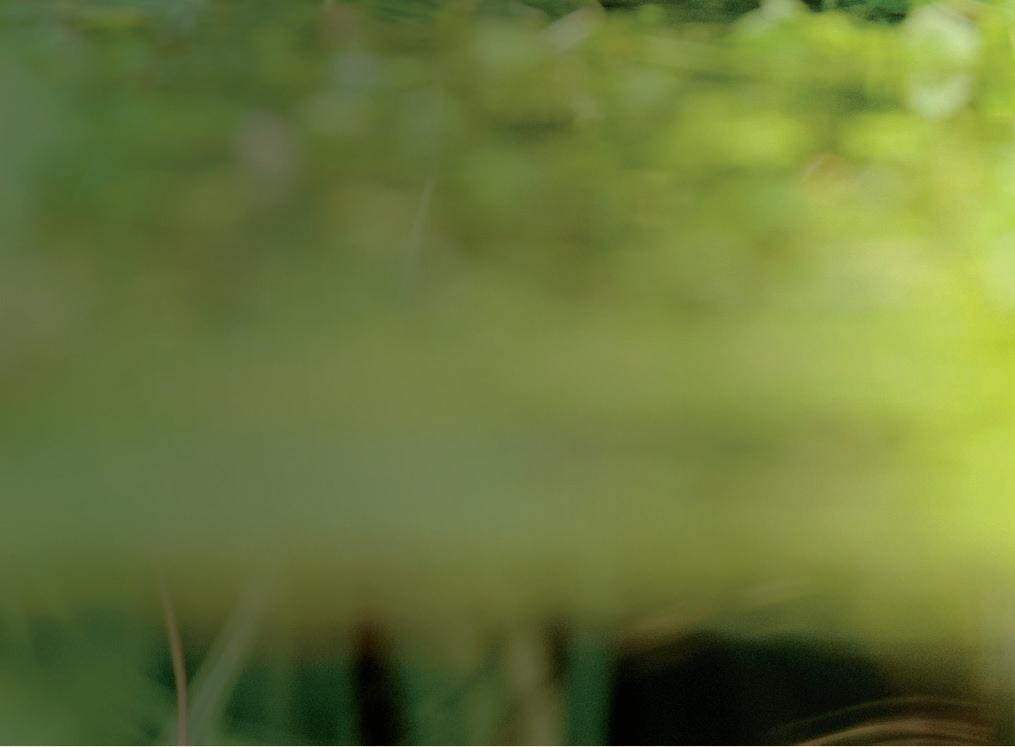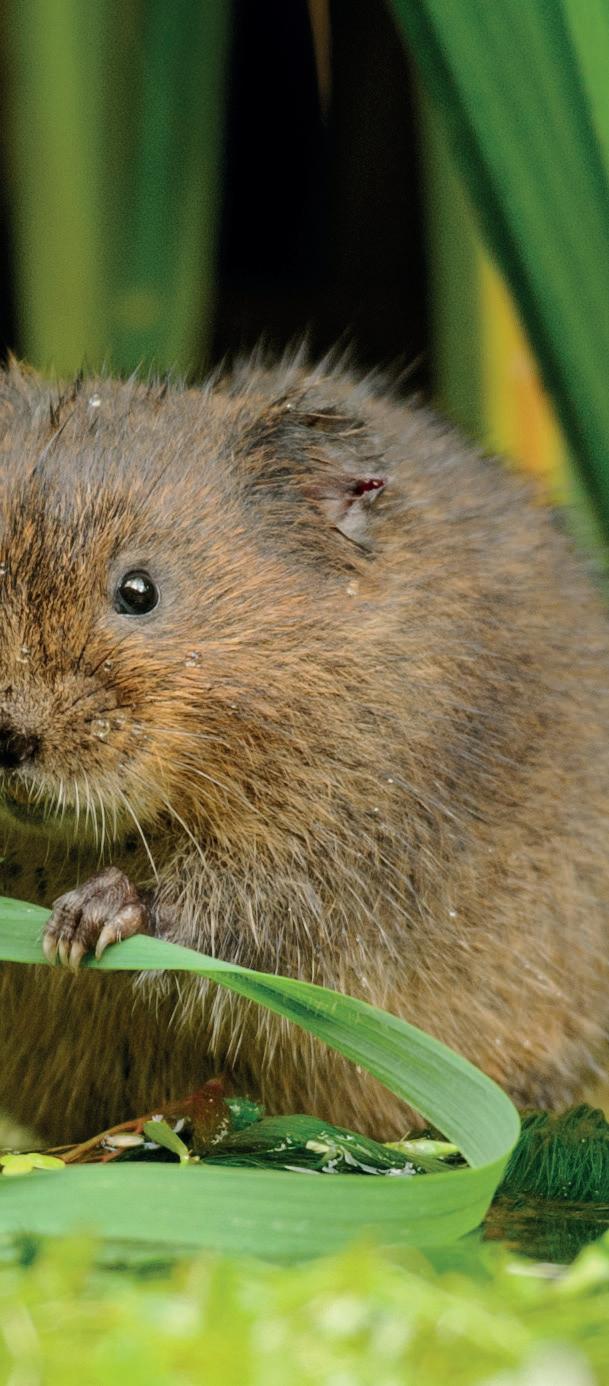



TOAD PATROL
TREE-MENDOUS
Explore our biggest treeplanting project to date
















Explore our biggest treeplanting project to date












This autumn delegates from more than 190 countries met in Columbia for the United Nations Biodiversity Conference (known as COP16) to discuss how to protect and restore nature. The aim was to establish international agreements, delivering the global target to protect 30% of the planet for nature by 2030. The Wildlife Trusts were present throughout the conference.
Progress by countries has been frustratingly slow and, sadly, a new framework for monitoring progress on tackling biodiversity loss was not agreed on and will need to be revisited over the coming year. We are already a quarter of the way towards the target date, yet the path to make it happen remains unclear.
This is why our work, backed by your support, is so crucial. Together we are helping to deliver nature restoration while doing all we can to hold governments to account.
All this concern makes it even more important to celebrate the successes. Areas where nature has already recovered offer much-needed hope. In our counties, for example, the Rutland Osprey Project has proved an outstanding triumph, demonstrating what is possible in the most splendid way. Turn to page 12 to read more on this. Then there is the magnificent tree planting at Holwell Reserves (see page 24). Activities like this are crucial to restoring natural processes and building networks of connected areas for wildlife.
Winter is a fantastic time to enjoy nature, as wildlife is pared back to its raw beauty. Short-eared owls, starling murmurations, the tracks of an o er or fox, winter gnats in a woodland glade or, my favourite, stunning cobwebs covered in dew are all out there to see. And it won’t be long before spring bursts onto the scene for another season of wild wonder!
In the meantime, have a fantastic winter and thank you for all your support in helping nature recover.
Mat Carter CEO


WILD Leicestershire and Rutland is the membership magazine for Leicestershire and Rutland Wildlife Trust and is free to members.
Email info@lrwt.org.uk
Telephone 0116 262 9968
Address The Old Mill, 9 Soar Lane, Leicester, LE3 5DE Website lrwt.org.uk
Registered charity number 210531
facebook.com/leicswildlife
x.com/leicswildlife
instagram.com/leiceswildlife linkedin.com/company/leicswildlife
Protecting and enhancing the wildlife and wild places of Leicestershire and Rutland and engaging people with nature.
Leicestershire and Rutland Wildlife Trust
Chair Ann Tomlinson
Vice Chair Bob Bearne
Hon. Secretary Peter Williams
Hon. Treasurer Andy Thorpe
CEO Mat Carter
Head of Reserves Joe Davis
Head of Nature Recovery Ben Devine
Supporter Development Manager
Josephine Taylor

The Wildlife Trust Magazine Team
Editor Benedict Vanheems
Designers Kolt Graphic Design
UK Editor Tom Hibbert
UK Designer Ben Cook
Cover image Phil Savoie, naturepl.com
Views expressed in this magazine are not necessarily those of the Editor, CEO or the Council of the Trust. Articles, letters, photographs and artwork are welcomed on the understanding that no liability for their safe custody or return is incurred and the right to abridge or refuse publication is reserved.


6
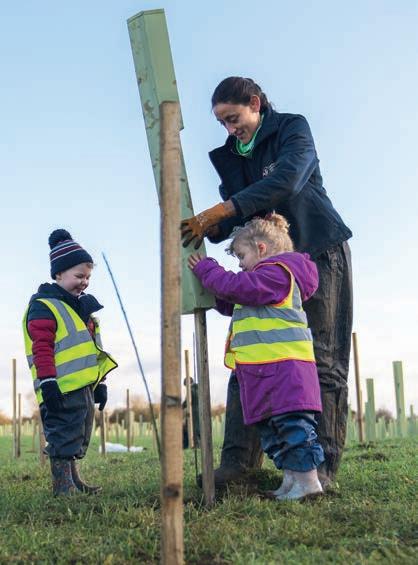
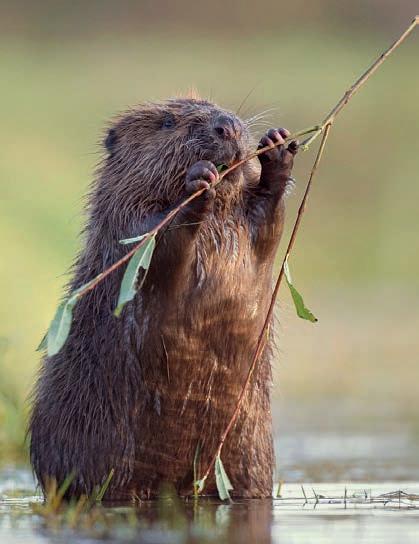
4 Wild news
All the latest stories from LRWT and around the country.
10 Your Wild Winter
Be awestruck at the irruptive migrations of waxwings.
12 Our awesome ospreys
The remarkable impact of the Rutland Osprey Project.
14 Toad patrol
How a group of volunteers saved the toads of Coleorton.
16 You’re a hero!
How our last appeal is already helping local wildlife.
18 Winter wander
Explore the ancient woodland of Prior’s Coppice.
20 Natural connections
Bringing spirituality to a natural world in crisis.
24 Taking root
The Trust’s biggest tree planting project takes root.
28 My Wild Life
Meet Marilyn, who helps older people connect with nature.
30 Beavers are back
The remarkable reintroduction of beavers to Britain.
34 Events and activities
Join one of our events and feed your wild side.
Local groups Join one of our friendly local groups and make a difference for wildlife near you. lrwt.org.uk/local-groups
Fundraise From taking part in a sponsored run to organising a tea party, you could help us raise funds. lrwt.org.uk/fundraise
Volunteer Could you offer your skills and time to help look a er local wildlife? We would love to hear from you. lrwt.org.uk/volunteer
Campaign Play an essential role in raising awareness and lobbying on local and national issues. lrwt.org.uk/campaign
Businesses Join as a corporate supporter of LRWT and put wildlife at the centre of your business. lrwt.org.uk/corporate
Legacy Leave a lasting legacy for local wildlife by remembering the Trust in your Will. lrwt.org.uk/legacy
The bats can be tracked at the tap of a button.


Local bats are taking centre stage in an innovative wildlife monitoring initiative as the Nathusius’ pipistrelle becomes the first species in the area to benefit from the Motus Wildlife Tracking System.
Motus is a global research network that uses radio telemetry to contribute to research on migratory animals. Using the technology on the bats is set to revolutionise our understanding of these elusive nocturnal creatures and their migratory pa erns.
Despite first being recorded in 1940, our knowledge of Nathusius’ pipistrelles remains limited. At first it was thought they were nomadic non-natives, but ongoing research reveals these bats do consider the UK as home and that they
50 years ago, work started on Rutland Water Reservoir. Originally named Empingham Reservoir, it would become England’s largest reservoir. Rutland Water Nature Reserve o cially opened the following year, in 1976.


are frequently found near large bodies of water such as Rutland Water.
The migration pathway of the Nathusius’ pipistrelle is quite remarkable. While the males typically remain close by, the females embark on extraordinary journeys, migrating distances of up to 2,000 kilometres.
Tom Benne of the Leicestershire and Rutland Bat Group offers further insight: “In autumn, these tiny-but-tenacious travellers make their way back to the UK from as far afield as Scandinavia, seeking milder conditions for hibernation and possibly mating. The bats then return to Europe in early spring. It is thought that a higher percentage of females undertake this journey to give birth in Europe.”
Traditional methods of monitoring, similar to bird ringing, rely on recapturing
incredible!
Gambolling otters have been captivating onlookers at Lyndon Nature Reserve, where visitors can admire the playful mammals on one of our hugely popular early morning otter watches. These two-hour events, run throughout the winter, o er a unique opportunity to spot the otters in their
natural habitat – possibly even catching them in action as they sh. Explore a variety of hides as you enjoy a range of wildlife. Bring binoculars and a sense of adventure! For a full list of dates visit the events webpage at lrwt.org.uk/events and search ‘otter’.
the bats and extensive manual data entry. The Motus system on the other hand combines radio and Wi-Fi technology to send information directly into a global database, dramatically reducing the time and resources required for data collection and analysis.
The first Nathusius’ pipistrelle bats were tagged at Rutland Water this spring, with the aim of tagging and recording more individuals over time. It is hoped that the technology will deepen our understanding of the behaviour and habits of these incredible mammals.
Species and Recording Officer Tim Sexton adds: “With enough funding, we could expand this project into so many other areas of our work, tagging a variety of species and allowing data collection to really drive forward conservation efforts.”
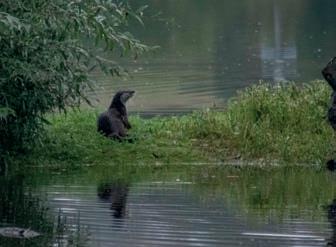
In November we welcomed more than 100 members to our 68th Annual General Meeting and our rst-ever Members’ Weekend. It was fantastic to meet so many of you and we thank everyone who attended, whether in person or online. We are especially grateful to John Everitt OBE, Chief Executive of The National Forest Company for his engaging talk.
We are delighted to announce the appointment of six new Trustees to the Trust:
• Andy Abbott, Professor of Chemistry at the University of Leicester
• John Atherton, Non-Executive Director at University Hospitals Birmingham NHS Trust
• Taras Bains, Junior Professional, World


Heritage for the International Union for the Conservation of Nature
• Gemma Harper, Chief Executive of the Joint Nature Conservation Committee
• Charlie Hewitt, Digital Ecologist
• Emily Hunter, Policy Advocate on Land Use at the Woodland Trust.
The recording of the AGM is available on our YouTube channel – youtube. com/@lrwt56 – and you can learn more about our new Trustees at lrwt.org.uk/AGM

Last winter we were approached by Tony Clarke, a regular visitor to Rutland Water Nature Reserve, who offered to fund improvements to Fran’s Pond. The pond is named a er the former Reserves Officer who created it.
Over time the area had become increasingly choked with vegetation and during the summer it wasn’t even possible to see the pond!
Tony is very keen on his dragonflies and believed that with some work the pond could be transformed into one of the best ponds on the reserve for dragonflies and damselflies.
Parts of the pond were
extended and deepened late last winter, and a boardwalk installed to enable visitors to get close to the pond and enjoy its wildlife. All of this relied on the incredible hard work of our dedicated volunteers.
The project has been a huge success with 17 species of dragonflies and damselflies already recorded. Come and visit to admire the new boardwalk and watch out for beguiling onthe-wing wildlife as warmer weather returns. Fran’s Pond is to the south of the Anglian Water Birdwatching Centre at Rutland Water Nature Reserve. For visiting details head to lrwt.org.uk/awbc
The smallest beetle in Europe, measuring just 0.4mm long, has been discovered at Rutland Water Nature Reserve, marking only the third time it has been recorded in Britain. The discovery was made by Senior Species and Recording O cer Tim Sexton following a fungi foray walk led by Tim as part of October’s UK Fungus Day celebrations.
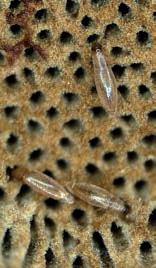
The tiny beetle, Baranowskiella ehnstromi, is a member of the feather-wing beetle family that feeds mainly on the spores of the bracket fungus Phellinus conchatus, itself scarce in Britain, with fewer than 100 records.
In total, 134 species of fungi were identi ed at Rutland Water during the two forays that ran over the Fungus Day weekend. Among them were a handful of new species to Leicestershire and Rutland, including the bracket fungus found in Cherry Wood.
While researching the fungus, Tim found an article mentioning that the smallest beetle in Europe feeds almost exclusively on it, so he went back to where the fungus was found. As the beetles are so tiny, a piece of the bracket was removed for closer inspection under the microscope, and it was then that several of the tiny beetles were spotted crawling over the surface.
The discovery has been con rmed by the County Beetle Recorder for Leicestershire and Rutland.

Broad bodied chaser
Thank you to everyone who kindly upgraded their membership over the summer. Your additional monthly contribution will ensure we can do even more to protect local wildlife as we continue to work tirelessly towards nature’s recovery. If you would like to upgrade your membership please visit lrwt.org.uk/upgrade















How we’ve been inspired by our members, volunteers and supporters.
Over the past year we have worked with community group Sensational Vibes to create a garden to serve the local community in Highfields, Leicester. Kamala Wisdom, CEO, invited us to a meeting in which we discussed potential opportunities for people to engage with nature. With support from Leicester City Council, Sensational Vibes was given land to tend and funding to get started. Beginning last winter, we cleared and prepared the space ready for spring, tidying what was a slightly neglected garden.
Also supporting Sensational Vibes is Sally Pearce, Director of Foundation Training. Among many talents, Sally is a keen gardener who has offered advice and brought on seedlings for the garden. Together we have shared knowledge, grown vegetables, explored the minibeasts that live there, and shared the fruits of our labour! We have renovated the pond with the help of our friends at WildWater Ponds, and added more plants, rocks and logs to create a variety of wildlife habitats.
The ongoing work to reach the wider community isn’t without its challenges, but there is interest, and we know these things take time.
Kamala has great aspirations for the community: “As an urban area, Highfields has limited green space and opportunities for residents to connect with nature. By creating new green spaces in the





heart of Highfields, we not only beautify the community but, more importantly, provide residents with more chances to engage with nature and experience its many benefits.
“The journey so far has been both




exciting and rewarding. Partnering with Foundation Training and Nextdoor Nature has opened doors to new learning and insights. Our ambition is to develop a beautiful, accessible green space that the community can call its own and that benefits everyone.”
In exploring ways in which a community green space can serve the local community, Sally has also delivered a Nurture Through Nature mindfulness course funded by Community Foundation, on behalf of the organisation Now Unlimited. Sally explains: “This programme was developed in response to the mental health crisis. We found mindfulness and nature increases an individual’s resilience to life’s challenges. By becoming conscious of the nature around us and beginning to understand how we can learn from it to develop our own resilience, we can appreciate how nature can reenergise us.”
The course explored what it means to be mindful from a personal perspective, how we can learn from nature, mindfulness practices and self-care, and how we can make nature a living part of our makeup.
As we strive to develop ideas from within the community, we are seeking another space that we might further develop within Highfields. If you think you can help or would like to know more, please email Fee Worton, our Nextdoor Nature Community Organiser at fworton@lrwt.org.uk




I am a person who cannot stay still for very long. Hiking and going on adventures are part of my DNA. Whether it’s discovering new corners of the world or right here at home in the UK, ge ing outdoors is so good for our physical and mental health. Plus, there is so much to see and learn about; we share the planet with so many amazing flora and fauna.
As a child, I would spend time playing outside with my friends at the park, running down alleys to the brook behind my house. We used to go looking for black and white caterpillars and frogs, and we would leave water out for the hedgehogs living in our garden. Sadly, you don’t see them anymore, which is one of the reasons I am so excited to be working with The Wildlife Trusts, to find ways to inspire young people to connect with and save nature. Hopefully, we can bring our spiky friends back from the brink.
In school, I always enjoyed spending time outdoors doing sports: cross-country running, rounders and netball. But when I started work, I lost that connection to the outdoors and nature. This is something I hear from people all over the UK – they are desperate to connect with the environment but not sure how. That used to be me.
If you live in an urban area, it’s hard to find like-minded people who want to experience the outdoors. When you do find groups, most people are white. It’s not that those groups are all unwelcoming to a black woman, it’s just that there are shared cultural experiences that only Black women experience. I find strength, security and bonding in those situations.

But we needed to challenge stereotypes in outdoor adventure and within our community. So, I started Black Girls Hike, a small weekly meet-up group of nine or 10 people so that we were among like-minded and non-judgmental people. BGH is owned by the members, and collectively we challenge the norms and break down barriers for future generations. Now Black Girls Hike is a multiaward-winning national organisation with tens of thousands of members.
I love exploring different terrains, from mountains, hills and forests to coastal walks. I absolutely love the Peak District. I took Clare Balding there for the first time, which is really strange because she has been to loads and loads of places. I remember thinking that’s like when people say they’ve never seen Sister Act or Dirty Dancing. But my favourite walk is from Robin Hood’s Bay to Ravenscar in Yorkshire. It is so beautiful.
My top tip: a waterproof jacket is essential. But when I get my foam sit mat out, people o en say, ‘Oh, that’s so handy, I’m going to get one of those.’
The Wildlife Trusts believe that everyone should have the opportunity to experience the joy of wildlife in their daily lives and are committed to putting equality, diversity and inclusion at the heart of our movement. Find out more about our Wild About Inclusion approach, which includes ensuring more people from across society have better access to nature.
wildlifetrusts.org/commitment-to-edi
The Leicestershire and Rutland Wildlife Trust manages 35 nature reserves supporting a wide variety of wildlife. They offer unrivalled opportunities to get out and explore the natural world. Choose your next wild adventure at lrwt.org.uk/naturereserves or turn to page 18 for our guided walk around the magnificent Prior’s Coppice nature reserve.
Rhiane Fatinukun MBE shares how her desire to reconnect with nature led her to become a globetrotting hiker, adventurer and founder of the UK’s largest outdoor collective, Black Girls Hike, dedicated to empowering black women and girls to explore the great outdoors.
Community gardening with Avon Wildlife Trust
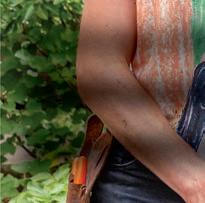


n two years, the UK-wide Nextdoor Nature project, backed by a £5 million grant from The National Lo ery Heritage Fund, has empowered over 400 communities to restore and enhance nature in their local areas. This achievement far exceeds the original target of engaging 200 local groups, demonstrating the project’s impact.
At the heart of Nextdoor Nature is the dedication to equipping individuals and communities with the skills and resources needed to take meaningful environmental action. To achieve this, community organisers were funded in every UK Wildlife Trust, with a focus on reaching communities that have traditionally been excluded from environmental and conservation efforts.
The Nextdoor Nature project has much in common with the grassroots of The Wildlife Trusts movement where passionate local people come together to create positive change for nature. For those who get involved, they also create heart-warming connections, experiences and memories.
The stories shared here are just a glimpse of what has been achieved through Nextdoor Nature. From a


mental health support group in Durham finding solace in newly accessible gardens, to schools in Kent, the Isles of Scilly, and North Wales engaging in species reintroduction and habitat creation – each success story is a testament to the power of communitydriven conservation.
A key measure of Nextdoor Nature’s success lies in its sustainability. The project has established connections with other organisations and resources to ensure the continuation of this vital work. Notably, 86% of UK Wildlife Trusts have secured or are actively seeking funding to retain community organisers, ensuring the momentum built during these two years continues to grow.
Thanks to Nextdoor Nature, Wildlife Trusts have made a cultural shi as a movement towards a community organising or ‘Team Wilder’ approach, that is helping to make environmental conservation project more open and accessible to a diverse range of communities. The legacy of Nextdoor Nature is clear: empowered communities, equipped with the knowledge and passion to protect and restore nature, are now driving lasting environmental change across the UK.
Examples of Nextdoor Nature projects across the UK
• Gwent has trained the Newport community in bee and bu erfly surveying, enabling them to contribute valuable data to citizen science initiatives.
• Hertfordshire and Middlesex facilitated AQA accreditation in River Management for eight young people, opening doors to future conservation opportunities.
• In Radnorshire, a thriving grassland and verges group successfully negotiated reduced mowing with the local council, fostering healthier ecosystems.
• Warwickshire inspired local people to take ownership of their green spaces, leading to the independent launch of a Tree Mapping project to address the impacts of ash die-back.
• Here in Leicestershire we have helped communities develop three community garden projects, securing the funding needed for essential resources.
• Lincolnshire has developed a robust network of Nextdoor Nature Champions who are spreading their conservation message across the county.
A pioneering series of reports have revealed the vast amount of carbon stored within UK marine habitats, and the importance of protecting UK seas for tackling climate change.
The seas around the UK and Isle of Man cover nearly 885,000 square kilometres – over three times the size of the UK’s land mass. This vast area is host to different habitats that sequester and store carbon, known as ‘blue carbon’. They include seabed sediments, seagrass meadows, saltmarshes, kelp forests, intertidal seaweed beds, maerl beds and biogenic reefs, such as mussel beds and honeycomb worm reefs.
The Blue Carbon Mapping Project, completed by the Sco ish Association for Marine Science (SAMS) on behalf of The Wildlife Trusts, WWF and the RSPB, is the first time a country
has provided a comprehensive estimate of the carbon captured and stored in its seas, including within Marine Protected Areas (MPAs).
The report finds that 244 million tonnes of organic carbon are stored in just the top 10 centimetres of seabed sediments – principally made of mud – plus coastal habitats including saltmarshes and seagrass beds. The reports identify bo om trawling and offshore energy installation as the biggest potential threats to blue carbon stores.
The Wildlife Trusts, WWF and RSPB are calling on governments across the UK to strengthen protections for the most valuable and vulnerable blue carbon stores.
Find out more at wtru.st/blue-carbon-report
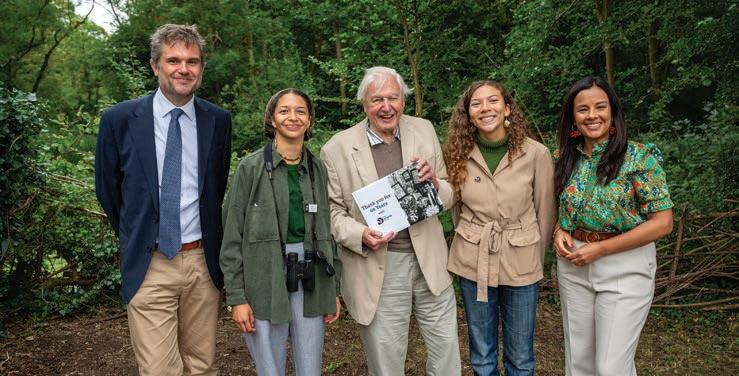
Sir David Attenborough has been awarded the Rothschild medal in recognition of the extraordinary leadership, inspiration and indefatigable support he has given to The Wildlife Trusts federation of charities over the past 60 years.
Charles Rothschild founded the Society for the Promotion of Nature Reserves which would later become The Wildlife Trusts. He was ahead of his time in recognising the need to protect natural habitats and the wildlife that lived there.
His daughter, Miriam, was a visionary scientist who dedicated her life to the natural world.
Sir David Attenborough credits Leicestershire & Rutland Wildlife Trust’s Tilton Cutting Nature Reserve with giving him his love of the natural world –he would explore it and search for fossils there as a young boy. Since then, Sir David has championed the work of the Wildlife Trusts across the UK for six decades.


Discover how The Wildlife Trusts are helping wildlife across the UK















Manx Wildlife Trust and theatre company, Hello Little People, have launched an audio-immersive wildlife training academy for kids, Let’s Get Wild! Wearing silent disco-style headphones, 5–9 year-olds move, shake and dance through an action-packed adventure to complete challenges and help save wildlife in the Isle of Man. wtru.st/LetsGetWild
North Wales Wildlife Trust is tackling invasive plant species with an innovative new mobile game. Players complete ‘missions’ on the Crowdsorsa mobile game by locating and recording the garden escapees, along pavements in urban areas or in nature reserves. Players are paid £1 for each new observation of target plants. wtru.st/GardenEscapers

O the Alderney coast, citizen scientists scuba-dive and snorkel for small tissue samples of the pink, warty looking soft corals of pink sea fans. Research by Alderney Wildlife Trust, University of Exeter and Jersey Marine Conservation is assessing their genetic connectivity across the rocky reefs of the Channel Islands.
wtru.st/PinkSeaFans


The best of the season’s wildlife and where to enjoy it on your local patch

Swooping into rowan trees and diving into hawthorn hedgerows, Bohemian waxwings are the most colourful of our winter visitors.
Every autumn waxwings move south in irruptive migrations from the boreal forests of Fennoscandia and Russia, flying long distances in search of their favourite food. Rowan trees, with their cascades of juicy berries, and ornamental shrubs like cotoneaster a ract them into shopping centre car parks. Haws and scarlet rose hips also offer a nutritious feast, and a flock of waxwings can strip a hawthorn in minutes!

| Winter/Spring 2025
Waxwings are certainly eye-catching. Their pinkish-grey body plumage is offset by black and white wings with saffron yellow markings. On its ginger-brown face is a sweeping black eye mask and throat, with a tall crest completing the look. Adult birds have small crimson blobs, like sealing wax, on the ends of their pinion feathers, hence their English name ‘waxwing’. Last year there were notable sightings of waxwings across the East Midlands. Will this year be another Waxwing Winter?
Thank you! Members like you help us do more for a wide range of birds, working towards a wilder future for all.
There’s plenty to keep us full of awe this winter.

Frogspawn beneath the surface ice should survive. Frogs continue to mate and produce spawn through to springtime. Newts and toads lay their spawn later in spring, usually after the risk of frost.

Amphibians hibernate in winter, don’t they? Certainly frogs, toads and newts spend the winter in dark, damp places, but they are not hibernating in the way some mammals do, they are just in a very deep sleep.
All amphibians are cold-blooded, which means their body temperature depends on their surroundings, and they are less active when temperatures drop. Some scientists prefer the term ‘brumation’ for the period of time when amphibians have low metabolic function and move slowly.
On warmer days amphibians temporarily emerge from their winter hideaways to feed and drink. Some male frogs spend the winter in sediment at the bo om of a pond or old washing up bowls dug into the ground. They
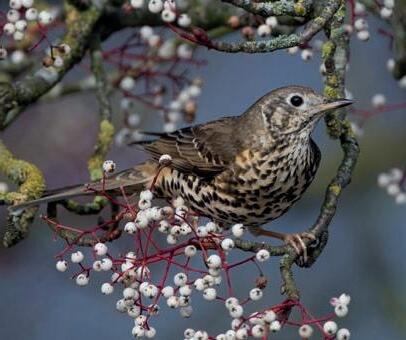

will survive winter so long as there is oxygen for them to breathe through their skin. Others find refuge beneath the relative warmth of compost heaps and log piles. You can help by stacking dead wood with leaves and soil in the autumn to create a safe place for brumating amphibians. Sweep snow and frost from frozen ponds to let light in. Maintain a small hole by floating a tennis ball on the surface then remove it once the surface has frozen over. This enables other wildlife to drink from the pond while ensuring more oxygen can reach the water.
Help garden wildlife survive the winter chill. For more tips visit: lrwt.org.uk/actions
Thrushes are a delight to see and hear. In fact, listening to them may be the best way to tell them apart. On cold winter nights the high-pitched ‘seeep, seeep’ call of the redwing indicates a flock passing overhead. Raucous ‘chack, chack, chack’s come from fieldfares on the lookout for berry-laden trees in farmland hedgerows. Mistle thrushes are noted for their dry ra le of a call and live here year-round. In winter they might perch atop holly trees defending their larder, or dangle precariously feeding on clumps of mistletoe.
Listen for the buzz of a queen bumblebee in a crocus ower. She’s on the search for nectar and will get caked in pollen as she delves deeper to reach it.
It may not feel like it, but the rst hints of spring are already upon us.
Mosses
Verdant green mosses and colourful lichens are easy to spot after winter rain. Look for them in churchyards, woodlands and growing on walls. There are more than 750 species of moss in Britain.

Nesting rooks
Noisy rooks start building their nests of twigs high up in trees from January. These social communities, known as rookeries, can contain hundreds of birds.

Early bulbs
Winter aconites and snowdrops were introduced to gardens and parks in the 16th century. Now naturalised, they make impressive displays brightening winter days.

Look for bluebell leaves piercing the woodland leaf litter. They will absorb the gentle sunlight, feeding the ower buds still forming below ground.
The regal osprey is a formidable hunter.


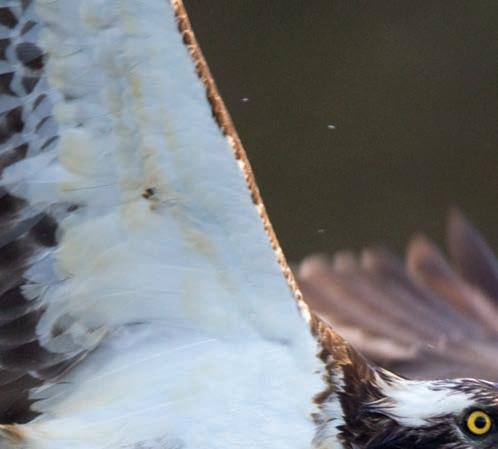
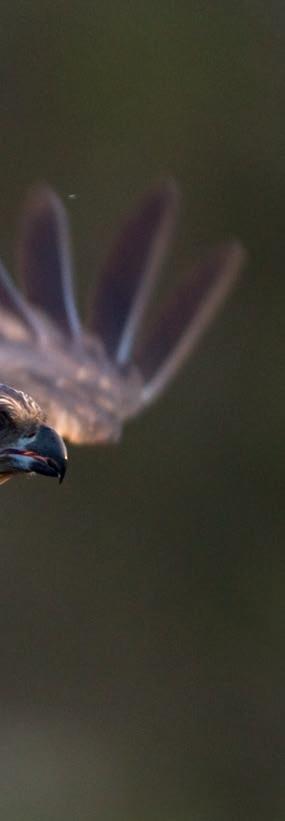


The sight of an osprey diving talons-outstretched to pluck a fish from the water must rank as one of the most amazing of all wildlife spectacles. Once synonymous with the lochs and coasts of northern Scotland, you are now just as likely to encounter a hunting osprey in central England, thanks largely to the success of the Rutland Osprey Project.
Once very rare locally, today ospreys are a far more common sight thanks to the pioneering vision of a dedicated team of experts and volunteers. Tim Mackrill, one of the earliest volunteers, shares the story behind the groundbreaking Rutland Osprey Project.
Our Rutland Osprey Project timeline
1996: The translocation project begins, with a total of 64 chicks translocated between 1996-2001.


1999: Two translocated males return to Rutland for the rst time.
In the mid-1990s, ospreys were on the increase in Scotland and becoming a more regular sight on spring and autumn migrations through England. As an exclusively piscivorous (fish eating) species, reservoirs like Rutland Water provided valuable stopping-over locations and some younger birds even spent the summer in England. However, the osprey’s breeding biology means that males in particular are nearly always drawn back to the area from which they fledged in order to breed, typically at three to four years old. This meant that the geographical expansion of the Sco ish population was painfully slow. This issue had also been encountered in North America, where the impacts of the insecticide DDT had decimated the breeding population. To counteract this, a new technique had been used to

2001: A pair of ospreys breed successfully for the rst time, rearing a single chick.
2004: Two translocated males are found breeding at di erent sites in Wales.




restore ospreys to their former range. Starting in the Tennessee Valley in 1979, young ospreys were translocated from areas with a secure population to release at wetland sites within the former range. The hope was that the birds would return to their release site to breed.
Rutland trial commences
The North American trial proved successful and encouraged by this permission was granted in 1996 for an experimental project to begin at Rutland Water to speed up the recolonisation of central and southern England. The pioneering project, led by LRWT, Anglian Water and the Highland Foundation for Wildlife (now the Roy Dennis Wildlife Foundation) was the first of its kind in Europe, though the team behind it felt sure it would work.

mainstay of the population for 15 years, rearing a total of 32 chicks.
Since that first success, a total of 278 chicks, including a record 25 in 2024, have fledged from nests in the local area, which extends from Rutland into Leicestershire and Northamptonshire. However, the legacy of the project extends much further.

people. Furthermore, it led me to set up the Osprey Leadership Foundation, which works to empower young conservationists at both ends of the osprey’s migratory flyway. At a time of great peril for the natural world, initiatives like this are more important than ever.
There is no doubt that the osprey can inspire people in a way few other species can. Every summer thousands visit the Lyndon Visitor Centre to view the famous Manton Bay ospreys or go on osprey cruises in the hope of seeing that magical moment when a hunting osprey plucks a fish out of the water. It is clear too that the osprey has an important role to play as a flagship species for wetland conservation, in the UK and across its range.

Young ospreys, aged five to six weeks, were collected in Scotland then translocated to Rutland Water where they were cared for by a small team of staff and volunteers before being released a few weeks later. I was fortunate to join the team as a young volunteer in 1997 and it was a real privilege to monitor the ospreys as they explored the nature reserve prior to beginning the long migration to West Africa.

The first real milestone came in 1999 when two translocated males returned to their adopted home. Then, in 2001, one of them, 03(97), paired with an unringed female to rear the first osprey chick in central England for 150 years. ‘Mr Rutland’, as he was known, became a
2005: A further 11 chicks are translocated to Rutland Water from Scotland.
Encouraged by the early work in Rutland, translocation projects followed in parts of Spain, Italy, Switzerland, France, Ireland, and at Poole Harbour in Dorset, thereby increasing the species’ range across Europe. Ospreys from Rutland Water have also helped the species recolonise Wales and, in 2022, a female, CJ7, who fledged in 2015, paired with a male that had been translocated to Poole Harbour and bred successfully for the first time. This was the first time ospreys had reared chicks on the South Coast for two centuries. We have also tracked individual ospreys on their incredible migration to West Africa, with some birds completing the 3,000-mile flight to countries such as Senegal and The Gambia in less than two weeks.
Some of the translocated birds were tracked on their first migration, and later we also followed adult birds as they headed to their wintering sites, which they remain faithful to throughout their lives. This has facilitated important links with conservationists and others on the wintering grounds and provided an amazing learning opportunity for young
2007: Ospreys breed in Manton Bay for the rst time.

2010: An unringed female known as Maya breeds in Manton Bay for the rst time. Overall, ve pairs rear a total of 12 chicks.


Mackrill working with the very rst
in 1997.
Read more about the Rutland ospreys and how to visit them at lrwt.org.uk/ rutlandospreys
The next generation
Calling all young conservationists aged 8-16. Join like-minded nature lovers and share your enthusiasm for wildlife (especially ospreys!) with the Osprey Leaders group. The group meets at Rutland Water every month. For details visit ospreylf.org/ospreyleaders-rutland
2015: Eight breeding pairs rear a total of 15 chicks. Over 100 chicks have now edged from local nests since 2001.

2023: 250th chick edges.
2024: Twelve pairs rear 25 chicks, meaning 278 have now edged from nests in the local area.





Fast cars and slow toads don’t mix, so when a new road in Coleorton threatened to cut o the village’s amphibians from their breeding pond, Rob Oldham knew he had to hop into action.

Since the early 1980s I have led a research group from De Montfort University (previously Leicester Polytechnic) studying the common toad population of Coleorton, near Ashby de la Zouch. Toads are notorious for migrating en masse back to their breeding ponds, and in the 1990s a new section of the A512 Ashby Road threatened to cut off the village’s toads from their breeding site. The road runs on land to the north of the Coleorton Fishpond, where a large and well-established population exists.
Adult toads return to Coleorton Fishpond every spring in order to mate

It was clear that the road would have a serious impact, obstructing both the night-time influx of toads from farm and woodland to the north of the pond during the early spring breeding season and the subsequent return of the adults. There was also the exodus of newly metamorphosed juveniles later on in summer to consider.
Tunnels and traps
During the planning of the road the group suggested the use of road surface tunnels. These tunnels are laid close to the road surface and would have enabled the toads to reach the fishpond safely during their spring immigration. This was rejected by the funding body. Instead, three large tunnels about a metre in diameter were placed deep under the road, with a concrete slab fence line added along each side of the road to keep the toads off the road.
Unfortunately, in early spring, during the immigration period, air in the tunnels is just too cold to support toad movement. This led to a build-up of individuals along the fence line. To solve this, we inserted pitfall traps and transferred the captured toads to the pond manually, on

safe transfer across the road.

a daily basis, carrying them in cloth bags or buckets. These individuals are then released into the northern edge of the pond approximately in line with the area where they were captured.
This approach has continued every spring since. Fortunately, once the air temperature increased during the warmer part of the year, the large tunnels (and the stream flowing under the road) did provide a useable route for the return of adults following breeding, as well as the movement of newly emerged toads.
Since the end of the student study groups in the 1990s I have been opening the pitfall traps each spring, during the breeding season, collecting toads and transporting them to the fishpond. This involves about 17 visits, starting in late February or March, depending on the weather. The toads move in towards the fishpond at night and collections from the traps can be made at any time during daylight hours.
Daily visits are sometimes necessary if there is a continuing spell of mild weather, but the influx is strongly influenced by temperature and on average there has been a gap of about three days between necessary visits. The typical number of toads transported comes to around 235 each year, but since 2005 has varied between 104 and 520.
Another essential task is clearing excess vegetation, especially brambles, along the fence line sometime in February, prior to the migration.
Although the impact of the road is broadly negative, the part of the population inhabiting land south of the fishpond has benefi ed significantly as a result of the reduction in traffic on the



Every year around 20 tonnes of toads are believed to be killed on the UK’s roads. Areas with large numbers of toad crossings can be registered with Froglife’s Toads on the Roads project. As well as coordinating local toad patrols, the project helps patrols apply for road warning signs from their local councils.



old Ashby Road. Before the completion of the bypass this part of the population was much more seriously affected by the traffic during the breeding immigration and the subsequent emigration than it is today.
In all parts of the country (including Leicestershire) the charity Froglife coordinates the intense annual activity of approximately 200 volunteer patrol groups. The aim is to reduce the decimation of toad populations on roads in areas close to breeding sites by moving individuals across the roads each night during the breeding season. Patrol groups move anywhere from 22,000 to 123,000 toads annually!
As data collection continues, there is still much to learn about the ecology of toads. Current procedures might help to add to our understanding of population trends.
In Coleorton the need for help with the toads was kindly raised by David Maltby at one of the Trust’s North West Local Group meetings earlier last year. Four volunteers came forward to lend a hand last spring, when a healthy 478 toads were transferred. With the continued dedication of volunteers like this, the future of the toad population at Coleorton looks secure.
Length: 8-13cm
Weight: up to 80g
Average lifespan: up to 4 years
Months active: February to October
Typical diet: slugs, snails and other invertebrates
Spawn: laid in strings, two rows of eggs per string

Your support will help us create a wilder future for all.
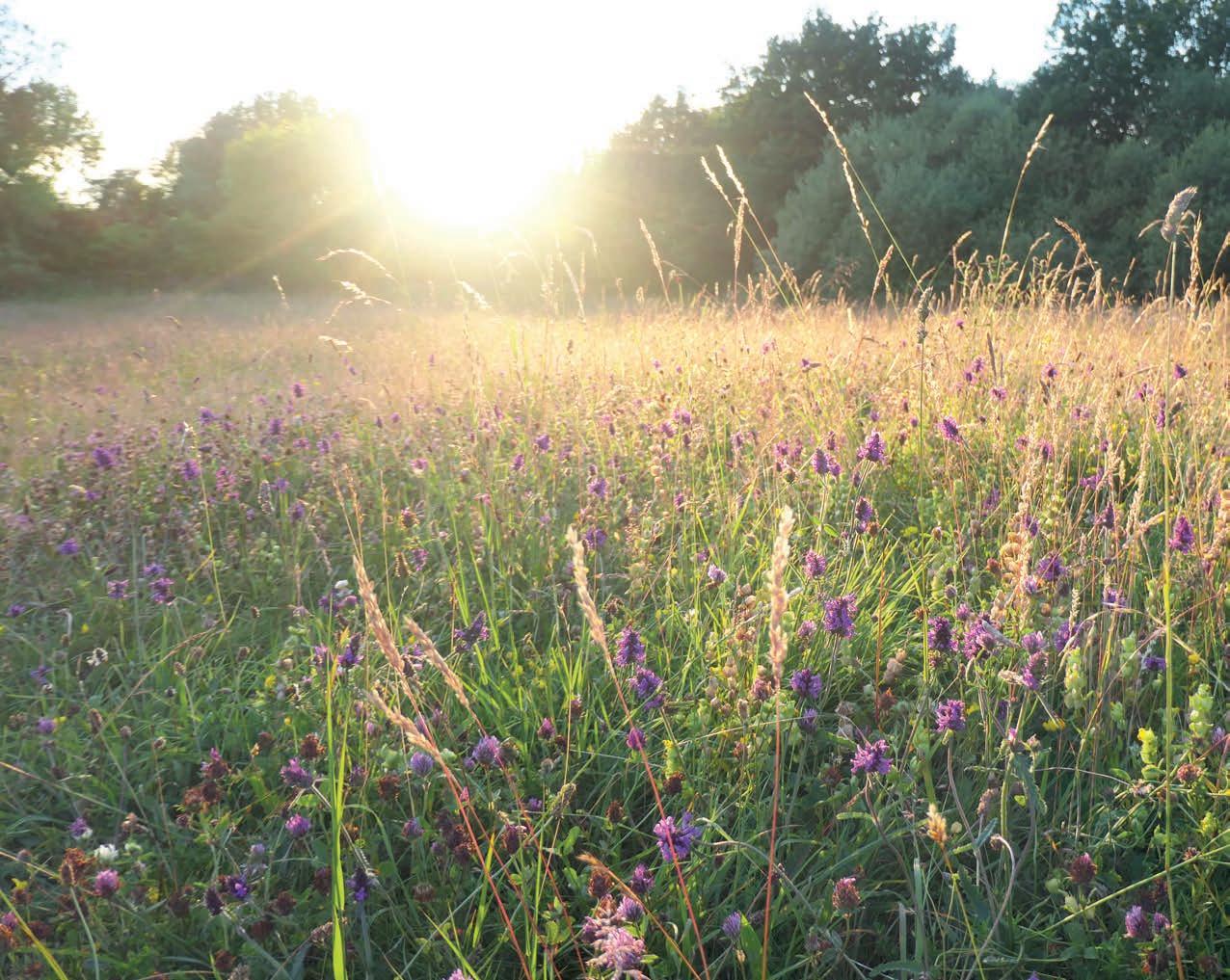
Thank you to everyone who donated to the Wild About Our Reserves Appeal. Your generosity is funding much-needed work across our nature reserves, ensuring a wilder future for Leicestershire and Rutland.
When we launched the Wild About Our Reserves Appeal back in October 2023, we knew it would be an ambitious ask. Improving biodiversity through new plantings, ponds and infrastructure are big projects requiring intense effort. But we also knew that this vital work would have an immeasurable impact.
Your support has been truly humbling. The appeal raised a total of £150,000 and this money is already being put to good use on our reserves. We are making fantastic progress, thanks to you!
We wanted to share the impact your support is having, and you can feel rightly proud of all you have helped
achieve. Projects already set in motion are delivering tangible benefits:
• New steps at Ke on Quarry have resulted in dramatic improvements in visitor access.
• At Cossington Meadows a new tern ra has been launched, providing breeding habitat safe from predators.
• Some 40 metres of new fencing and a replacement gate have been installed at Altar Stones, and fencing repairs at Narborough Bog have ensured the meadows are now secure for conservation grazing.
Of course, we still have much more work both planned and in progress, such as the creation of new wildlife ponds, and
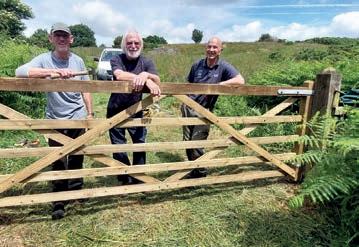
Admiring the newly installed gate at Altar Stones.
improvements to support grazing on our limestone grassland reserves that will benefit bu erflies and reptiles. It is heartening to know that so many people care deeply about wildlife across our two counties. You should feel incredibly proud of the difference you are helping us to make.

Reserves O cer Chris Hill new tern raft at Cossington Meadows.


Thanks to a dedicated team of volunteers, our Tuesday group at Cossington Meadows helped with the launch of the new tern ra . It looks splendid and we hope the terns will think so too. We would also like to thank Floats and Frames Ltd who made the ra for our lucky terns, while extending a special thank you to everyone who donated towards our appeal.
In these photos you can see us
mucky stuff and pu ing on fresh, clean gravel. If only the terns knew what we did for them!

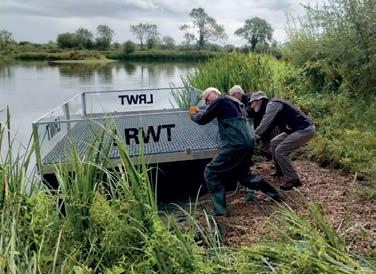



Improvements at Ketton Quarry have opened up access to this stunning reserve, as Sarah Bedford, Senior Reserves O cer explains.
Early last summer, staff and volunteers worked hard to create a new set of steps in a previously precarious area of the nature reserve. They also re-established a second flight of steps that had churned into a quagmire, leading to and from one of the public rights of way.
With funding through the Wild About Our Reserves Appeal, together with donations of aggregate from Mick George (through Heidelberg Materials), the steps took shape and now represent a dramatic improvement in access for visitors to this beautiful nature reserve.
Thanks to a dedicated team of volunteers, more than eight tonnes of limestone were laid down on a hot day at the end of June to give the steps their finishing touch. The paths are now reopened, and visitors can enjoy this chalk grassland reserve for its multitude of wild flowers and bu erflies.



Springtime aerial view of Prior’s Coppice.
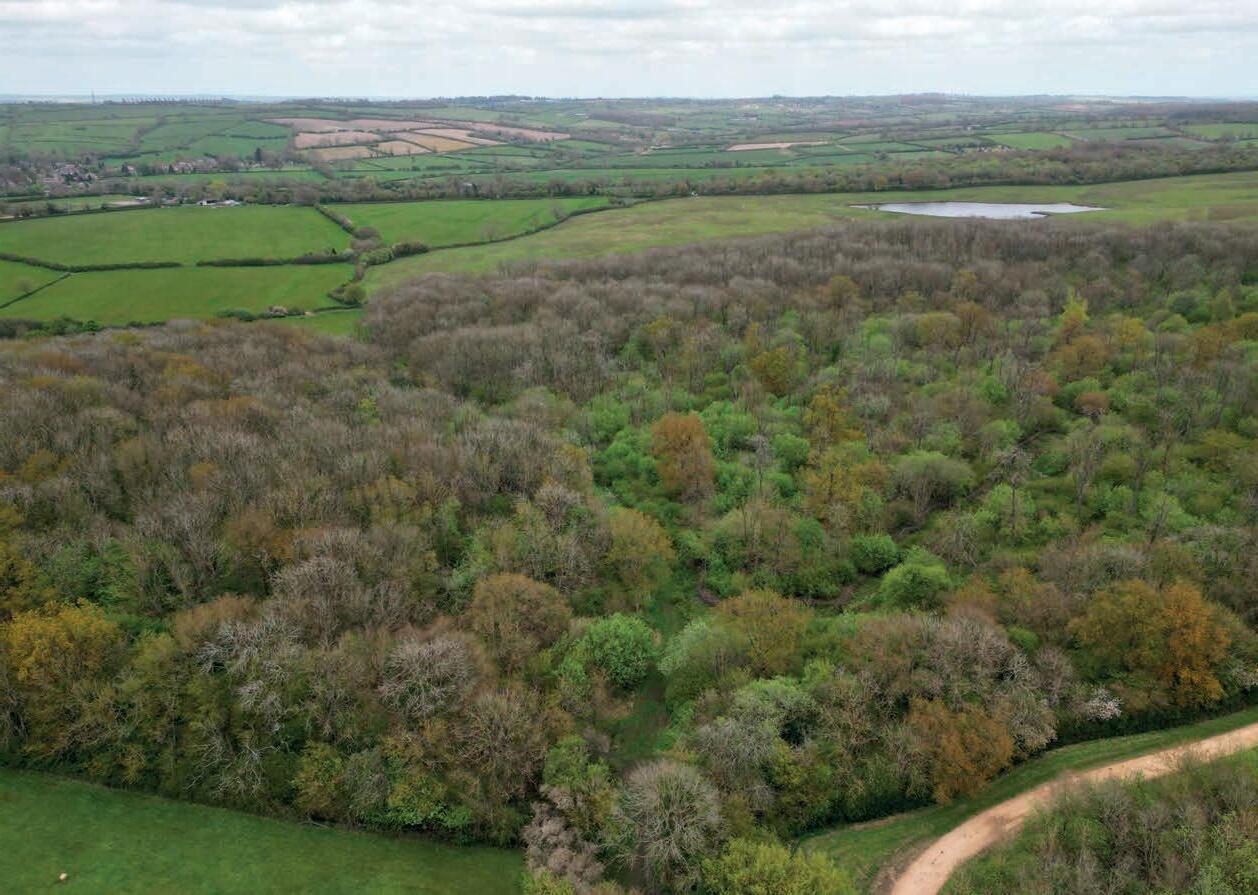



Prior’s Coppice is a hidden treasure waiting to be discovered – and there’s something for everyone to enjoy, whatever the season.
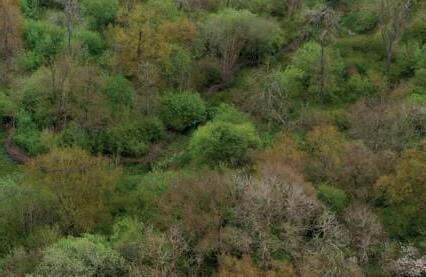

This ancient woodland is a Site of Special Scientific Interest and a must for plant lovers. The woodland could well be a relic of the wildwood that once covered the area following the last ice age as it seems the eastern side was never cleared for cultivation. The result is a real sense of stepping back in time.
The wood has existed on this site for hundreds of years and can be identified on John Speed’s 1610 map of Rutland. It is particularly rich in plant species – more than 230 have been recorded here to date. Ash and field maple are the main tree species, with oak and wych elm less frequent. Other shrubs and small trees

include hazel, willow, hawthorn, wild cherry and guelder rose.
Enter the reserve down the grassy track to a glade 1 where several paths meet. The main ride carries on down the hill, essentially dividing the wood into two halves. This division must have a long-standing historical basis since the parish boundary runs through the wood just to the east of the ride. It is also marked by the different character of the vegetation in each part of the wood. The western half was clear felled in the 1940s then le to naturally regenerate. The eastern part was not cleared and shows evidence of planting of specimen trees.
Take the path to your le along Pond Ride, named a er a small seasonal pond 2 in which water horsetail can be seen growing. Continue through an area actively managed as coppice 3 , where the trees and shrubs are cut down to the ground then le to regenerate as new shoots. For hundreds of years this traditional form of sustainable management supplied local people with wood for a wide variety of uses, including firewood, building
materials, and for tools and implements. Coppicing has many benefits for wildlife, offering nesting habitat for a range of birds such blackcap and garden warbler. Many woodland bu erflies and plants also favour these more open areas, which respond by flowering profusely. In spring look out for the white flowers of wood anemone and woodruff, the yellow of lesser celandine, and pale blue wood forget-me-nots.



Continue to the junction with Orchid Ride 4 , where a small glade has been created to provide open conditions for the many hundreds of common spo ed orchids that flower here in summer. You can make a slight detour here: turn le and walk up to the gate 5 at the edge of the wood, where there are views across the Chater valley. Launde Park Wood nature reserve can be seen to the southwest. Also note the new plantation on former arable land to the south, which will help


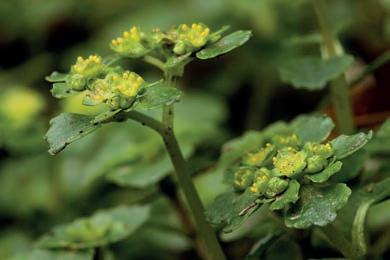
to reduce the isolation of Prior’s Coppice in an intensively farmed landscape.
From the glade 4 follow Orchid Ride down the hill until you see a footpath on your le 6 . Turn le onto this path and enter a part of the wood that hasn’t been coppiced and has developed into high forest. Shade-loving plants such as dog’s mercury thrive beneath the trees. The noticeably cooler, more humid conditions usually found here suit the many ferns found in this part of the wood.
Continue towards the edge of the wood where you will meet another path 7 Turn right. On your le look out for spurge laurel, a winter-flowering evergreen shrub indicating the chalky nature of the underlying boulder clay. Continue down the hill.



understated, green leaves and flowers, and a small purple fruit.

As you reach point 8 the soil becomes be er drained and more acidic, with different plant species thriving, including wood sorrel and broad buckler fern. In April, this is the best place to admire the bluebells, while in May and June you could hunt for herb-paris. Also known as ‘true lover’s knot’, it is much harder to seek out amongst the bluebells and primroses, with a crown of
Continue straight over the bo om of Orchid Ride 9 and follow the track on to Main Ride 10 . On either side of the path are sca ered clumps of hard shield-fern with its narrow, dark, leathery fronds. Cross the Main Ride and again follow the track parallel with the edge of the wood. This part of the wood was not clear felled in the 1940s and several large oak trees can be seen beside the path 11
At the end of the path 12 turn right, up hill, along Elm Ride. Wych elms can still be seen in this area, although Dutch elm disease killed many of the larger specimens. Other large trees include hybrid black poplars, an ornamental cross between European black poplar and North American eastern co onwood, and a once popular plantation tree. Although large, these fast-growing trees are probably no more than 100 years old, and several have already succumbed to age and fallen over. They have characteristic deeply grooved bark and grow with a slight lean. Patches of wood speedwell grow on the ride itself.

Continue until about halfway up the hill then turn right 13 onto a track heading back to Main Ride. Opposite-leaved



golden saxifrage grows abundantly in the very wet areas along this path. The tiny yellow flowers of this plant are one of the first to be seen in spring.
On reaching Main Ride 14 , turn le uphill back towards the entrance. If visiting in July you might spot the pale flowering spikes of broad-leaved helleborine, an orchid that grows along the coppiced ride margins. Continue at the intersection 1 to reach the car park and the end of the walk.
Please note, this woodland has been signi cantly a ected by ash dieback disease, seriously weakening some trees. Avoid entering the woodland during windy weather when the rides are unsafe for walkers.
Take the Leigh eld road from Braunston. After the sharp lefthand bend at the top of Wood Lane carry on for 900m and take the next right turn to Leigh eld. The reserve car park is 800m on the right, just before Leigh Lodge cottages.
Nearest postcode: LE15 8DB
Map ref: SK 832 049 what3words: bill.uppermost.attitudes Parking: Nature reserve car park Size: 29ha
For further information, please see our Nature Reserve Guide or visit lrwt.org.uk/nature-reserves




Some days it feels like we are in a desperate scramble to respond to the challenge of species and habitat loss, as well as an intensifying climate emergency. One upside of our experience of the sharpness of urgency has been a broadening in the category of environmentalism. Now it includes new or previously marginalised stakeholders and overlooked forms of care for nature.
As a general rule, sustainability has tended towards a default of elite, white, secular and scientific. In the research I was involved in last year on project Spotlight*, we identified a massive upswell of enthusiasm for environmental care and action among people of colour in the UK. A significant number of our respondents also linked their concerns to religious and spiritual traditions and identities.

These findings supported work I’ve done alongside everyday activists and environmentalists, where I’ve seen an exciting range of new initiatives coming up in the context of religious communities. This includes the Sikh Guru Nanak Sacred Forest project, aiming to establish a new network of sacred forests across the world. British Muslims are drawing on the Quran and Hadith to reclaim forms of thoughtful stewardship of nature.
This can also be seen in urban ecology projects: British Bahu Trust mosques are covered with solar panels and proactive in leading community clean-ups. Cambridge Central mosque is a true eco-mosque with a near-zero carbon footprint. The Eco-Church network, has grown from 250 to more than 5,000 British churches in a decade, making it one of the largest community networks of local environmental action groups in the UK. Woodlands, nature reserves, and other nonreligious environmental charities are also connecting with their stakeholders in more holistic ways. Given that so much of our work
restoring the landscapes we care about is about re-establishing forms of connection, it makes sense that many people are rediscovering their own environmentalism in the context of personal faith and spirituality.
But while conservation as a genre is opening up, there is still a lot of work to do. Are there aspects of ourselves that we still hold back and fence off from our concerns for wildlife? For example, the na erjack toad, hazel dormouse and hedgehog are all under threat of extinction. We might try to stretch our awareness to bring creativity to forms of love for creatures that we might find unlovely or pause to learn about new kinds of beauty.


By bringing spirituality to nature it can also help us navigate feelings of loss and disconnection, like the process of mourning a lost-through-melting Icelandic glacier. This might take the form of a slow walk, drawing close and leaning in to nature, even though we may want to flee for fear of grief. Why not treat walking footpaths, hills or the spectacular but fragile British peatlands as an eco-pilgrimmage?
It’s especially exciting to me that we are finally bringing spirituality to nature conservation as this can help us to forge deeper relationships, harmony and forms of connection with habitats and creatures.
*Project Spotlight is an initiative engaging people of colour with nature and climate change. You can learn more about the project at climateexperiences.org
This article by Jeremy Kidwell precedes a new blog series by The Wildlife Trusts exploring the intersection of nature conservation and climate change, religious faiths and spirituality. Each blog focuses on religious festivals or awareness days that highlight diverse spiritual perspectives on the natural world. View all blogs from The Wildlife Trusts at wildlifetrusts.org/blog


Jeremy Kidwell is an associate professor in theology at the University of Birmingham. He is the author or editor of a range of books including most recently a collection of essays edited with Stefan Skrimshire called Religion and Extinction.
















The honking calls of these large birds in ight is a clear signal that winter is on its way. Necks outstretched and beaks to the wind, swans and geese in a v-formation skein is an iconic sight.
There are three species of swans in the UK: the mute swan, whooper swan and the Bewick’s swan. The large, majestic and pure white mute swan is most recognisable and stays with us all year round in village ponds and waterways. Contrary to the name, the mute swan honks and snorts, while the whooper swan ‘bugles’ when feeding and in ight.
During the winter migration gaggles of geese ock together on UK wetlands. They graze on grassy banks, farmland, saltmarshes and seagrass meadows. The familiar Canada and greylag geese are joined by visitors such as pink-footed, white-fronted, barnacle and brent geese. Here are six of our best nature reserves for spotting swans and geese.

















See the spectacle for yourself ish






















1 Montrose Basin, Sco ish Wildlife Trust


The Montrose Basin is a large intertidal estuary, attracting tens of thousands of pink-footed geese every autumn. As well as being internationally important for pink-footed geese, the reserve is a wintering site for whooper swans and mute swans.
Where: Montrose, DD10 9TA



2 Holywell Pond, Northumberland Wildlife Trust
The nature reserve consists of a large pond surrounded by grassland, mature and semi-mature areas of woodland and scrub. Greylag, pink-footed, brent and Egyptian geese visit together with whooper swans, wigeon and tufted duck.
Where: Holywell, NE25 0LQ
3 Parc Slip Nature Reserve, The Wildlife Trust of South and West Wales
The wetlands and surrounding ponds at Parc Slip Nature Reserve are a fantastic haven for watching swans and geese during the autumn and winter. Its bird hides are perfectly positioned to keep an eye out for heron, teal, mallards, visiting lapwing and the resident Highland cattle that patrol the elds.
Where: Bridgend, CF32 0EH
4 Nature Discovery Centre, Berks, Bucks & Oxon Wildlife Trust
Take a seat in our shipping container bird hide or stay cosy in the ‘hide in the sky’ in the visitor centre. Both overlook the lake which is home to mute swans, Egyptian geese, Canada geese and greylag geese during winter.
Where: Thatcham, RG19 3FU
5 Cossington Meadows, LRWT
This wetland haven really comes alive in winter as rafts of ducks like wigeon and teal gather on the lakes, joined by a plethora of wintering geese and swans. The creation of ‘scrapes’ and new ponds has made this one of the best wildlife sites along the River Soar.
Where: Cossington, LE7 4UZ
6 Chesil Beach and The Fleet Nature Reserve, Dorset Wildlife Trust
The Fleet Lagoon in Dorset hosts a fabulous spectacle of up to 4,000 brent geese when they return from their Siberian breeding grounds. These handsome grey, black and white geese come for the winter to feast on the eel grass that grows here alongside a fabulous herd of mute swans.
Where: Weymouth, DT4 9XE
Did you spot any swans or geese?

We’d love to know how your search went. Please share your best photos with us!

Digging it: A hive of activity on one of the community planting sessions.




Last winter saw the Trust’s most ambitious tree planting project to date. Holwell Wood will grow into a new space for wildlife to thrive and people to connect with nature, as Senior Reserves O cer Sarah Bedford explains.

Planting a new woodland is an exciting project to be a part of, knowing that what is planted today will have a lasting impact. Woodland brings a long list of the benefits, from increased species abundance and be er air quality to climate change and flood mitigation. It also offers us a place to explore and connect with nature.
Last winter we were thrilled to plant new woodland at Holwell Reserves. More than 13,000 trees were planted on just over six hectares of grazing land, creating
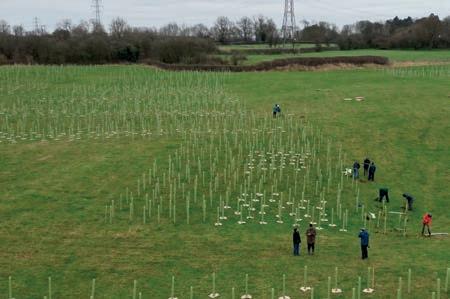
The new woodland creates more space for nature.

wildlife corridors and increasing the area available for nature to thrive.
The Trust was fortunate to receive a grant from the David Cock Foundation as well as an England Woodland Creation Offer from the Forestry Commission to bring this woodland project to life.
Once the trees and tree guards were delivered, there was the small task of ge ing them all into the ground at the right time. First came the contractors who planted 10,000 trees over 10 days with a team of just five people. This was not their first rodeo. With a slick system of driving in stakes and with bags of trees strapped to their belts, they glided across the site like a misty winter ballet. They made short work of bulk planting and achieved what we set out to do – get the lion’s share of trees in the ground before Christmas.
Tree planting season runs from November to March but, ideally, you want to be planting trees in early winter, when the ground is cold, the soil moist and there is plenty of humidity. Planting at this time means trees
Children from Little Rascals Day Nursery lend a hand.

should then need very li le a ention. This is also the start of their dormant period, so trees can concentrate on se ling in before spring.
Volunteer efforts
The contactors le us with around a quarter of the site still to plant. The final 3,330 trees were tackled by a combination
regular volunteers, members of staff, trustees, local residents, four generations of the same family from Ab Ke leby, children from the local nursery, corporate groups from Melton Mowbray, as well as groups of friends who had heard about the project at the pub. They all pulled on their wellies and picked up spades to help across 15 planting sessions and, together, were critical in helping us finish the job.
Planning the planting of the site and choosing an appropriate mix of species was supported with advice from the Forestry Commission. The woodland design takes into consideration our wish to use native species, the soil and topography of the site, and the expected resilience of species for a projected climate in the year 2080. The application also stipulated that more than 30 per cent of species should be native woody shrubs, to ensure a biodiverse mix of woodland with ecotones throughout.
Survival story
The very wet winter was less than ideal but while much of our land was miserably under water, the trees received the irrigation they needed. Nine months on and the trees are doing really well. A survey was undertaken at the end of their first summer to determine how
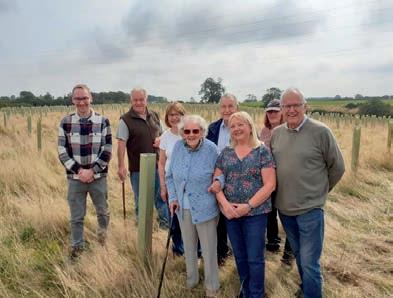
The Gri n family, Jean centre.


One local family was especially keen to be involved. Three generations of the Gri n family joined in at the 100th birthday request of their mother, Jean, planting an entire area of cherry trees while donating a further £450 to the project. The Gri ns are proud of their connection to Holwell Reserves and can see the new woodland from their house. The family visited the site again in summer to check on the progress of their trees.
planting needs to be done. Some natural thinning is to be expected and will create a diverse structure within the woodland, including vital open spaces that will a ract their own specialist species.
The future management of the wood is integrated into the nature reserve’s overall management plan, including annual maintenance of the rides, care of
With a slick system of driving in stakes and with bags of trees strapped to their belts, they glided across the site like a misty winter ballet.
many trees were surviving. Random plots were surveyed with an average survival rate of 92 per cent. This will help to inform how much, if any, replacement

Summer and some of the saplings are already proud of their guards.
the young trees, removing tree defenders at the right point in the trees’ lifecycle, and installing infrastructure such as gates and seating.
This is the biggest tree planting project Leicestershire and Rutland Wildlife Trust has undertaken to date and there are aspirations to complete similar work on other reserves in the future. Learning lessons from this site, no doubt the volunteers will be asked to dust off their spades and get planting again soon! In the meantime, a woodland has been created where once there was an empty field.
Holwell Wood is now establishing for everyone to enjoy. This is a valuable natural asset in the Leicestershire landscape that many local residents can take pride in knowing they helped to create.
The planting mix includes 19 species of trees and shrubs, with no single species making up more than 8% of the planted area. Species include the following.
Field maple: Hosts a range of aphids and caterpillars, fuelling wildlife higher up the food chain. It has fantastic autumn colour.

English oak: This majestic and much-loved oak supports more wildlife than any other UK tree species.
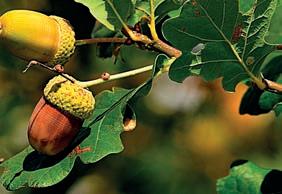
Small-leaved lime: Famous for its heart-shaped leaves, the smallleaved lime is a magnet for many moth caterpillars.

Common alder: Rot-resistant alder is the ideal choice for the wetter patches of ground at Holwell.
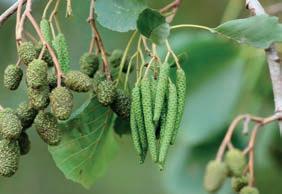
Ecology, conservation and wildlife gardening teacher, Paul Ritchie, shares his most loved garden fruit trees that offer a bounty of flowers, berries and fruits. These eight trees will boost wildlife in any garden, while offering treats for your winter kitchen store.
Fruit trees are fantastic for wildlife and a great way of making space for nature in gardens. Wild fruit trees offer homes for numerous insects at all stages of their lives, nesting birds and small mammals such as bats. Vitally they also provide year-round food: blossom is nectar for wild bees emerging from hibernation, while leaves and the fruit feed moth caterpillars.
Fruit trees in blossom are beautiful but they have a broader benefit for the natural environment and for people too. They improve soil quality, filter the air and slow water run-off which reduces flooding, as well as providing shade in hot weather and lessening noise pollution. I plant native hedgerows to provide wind breaks as well as shelter for wildlife such as hedgehogs and house sparrows.
Choosing a tree
You do not need a big garden to grow fruit trees and some smaller varieties will grow happily in pots.
When I am choosing the right tree for the right place I always consider:
• Height: The mature size should be appropriate for the available space. Especially important if there are buildings, telephone cables or powerlines nearby.
• Shape: The average dimensions of the tree’s canopy spread will affect shading and space so, slender trees such as rowan are ideal for smaller gardens.
• Soil: Check the label when buying a tree for its hardiness to drought and preference of soil type to match with your garden – e.g. clay, chalky, sandy or loam soils.

I suggest buying trees as bare-root whips to plant in winter, but po ed trees can be planted all year in square holes. Remember that fruit trees can be pruned to suit your own garden and needs.

Paul Ritchie is a biologist, passionate about trees, outdoor learning and connecting people with nature. He has worked for City of London Open Spaces, Surrey Wildlife Trust, and now teaches at Royal Botanic Gardens Kew and RHS Garden Wisley.
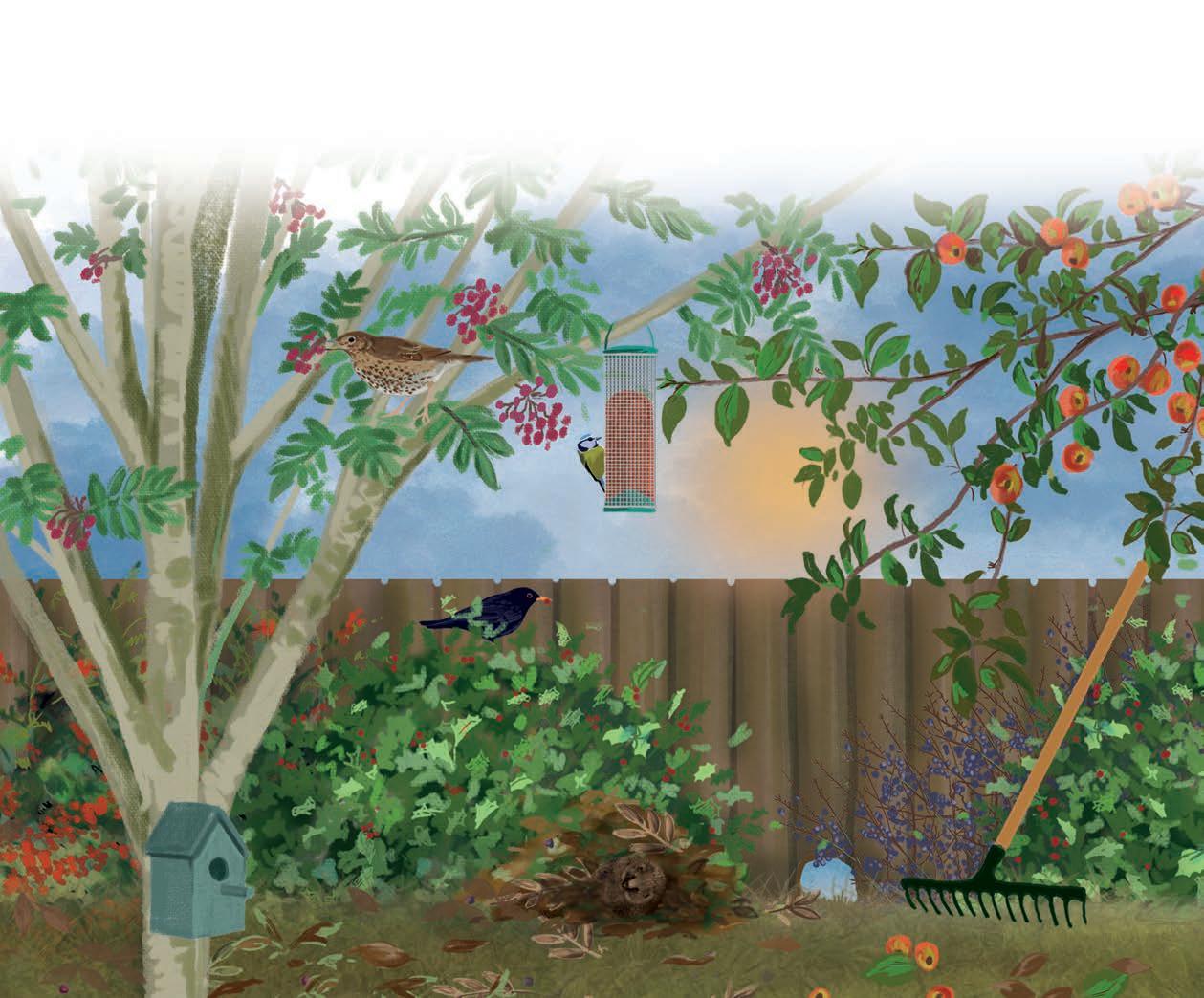
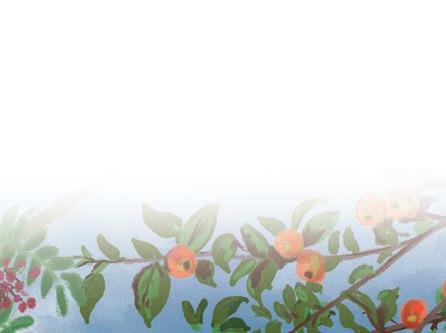

Rowan (Sorbus aucuparia) or ‘Lady of the Mountains’ produces large clusters of scarlet berries loved by redwing and fieldfare and used as a sugar substitute for diabetics.

Hawthorn (Crataegus monogyna) or ‘Mayflower’ supports hundreds of different insects, and its berries can be used to make ketchup, chutney, jam and beverages.

Crab apple (Malus sylvestris) has small apples loved by hedgehogs, mice, voles, fox and deer and, if cooked, as jelly, chutney, cordial or brewed as cider, is enjoyed by humans too.
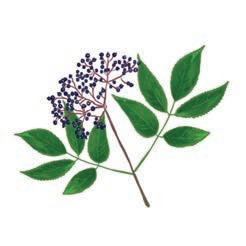
Elder (Sambucus nigra)
We use the clusters of creamy flowers and black berries to brew cordials, champagne and wine, whilst the berries are loved by thrushes and blackbirds.
For more information and advice on planting fruit trees in your garden, visit mycoronationgarden.org

Holly (Ilex aquifolium) has evergreen leaves that are slow to break down, so hedgehogs, small mammals, toads and slow worms hibernate in the leaf li er under the tree.
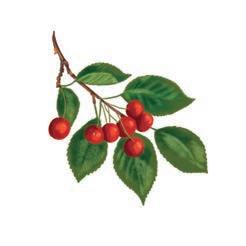
Wild cherry (Prunus avium) has fruit suitable for making jams, puddings, chutneys, soups, vinegar, cordials, wine and beer.

Blackthorn (Prunus spinosa) is culturally linked with Hallowe’en and, like many wild fruits, sloe berries have medicinal uses as well as being used to flavour gin.

Wild plum (Prunus insititia) or bullace grows in hedgerows and, whilst smaller and less sweet than domestic plums, it can be stewed to make fruit preserves.
After a lifetime teaching, Marilyn Bowles shares her skills to help older residents of the MHA Aigburth Residential and Dementia Care Home in Oadby get the most from their gardens, as she explains to Wendy Tobitt.
What benefits do older people gain from the gardens?
The opportunities to use all their senses!
Residents see trees and plants from their rooms and the communal areas. Those who venture into the gardens tell us they see something new every day. Being outdoors can release their emotions. They recognise plants they had in their own gardens and plants that ‘tell’ them what season it is.
This stimulation of memory is very evident with residents with dementia. They remember plant names, while the smells when handling flowers can prompt them to reminisce. We have a scent trolley to bring the garden closer to people in wheelchairs.
How did you get involved?
In 2018 I visited my aunt when she lived at Aigburth, and I was appalled by the state of the garden. Several people with relatives at the home felt the same way, so we offered to rescue it. Our first task was to improve the soil. We persuaded the


“I love seeing residents enjoying the gardens”
kitchen staff to collect vegetable scraps and started to make compost.
We are a team of five volunteer gardeners, average age 74: Alan Stead, Mary Bryceland, Fred Palmer, Jan Brown and me, with invaluable help from the Care Home’s Gardening Club and volunteers Pam Lambert and Marie a Sharp. Most of us commit a few hours a week. To fund our work, we run a £1 stall
to raise money and receive donations from the Friends of Aigburth coffee mornings.
Do residents get to participate?
I love seeing residents enjoying the gardens and doing what they can in the Aigburth Gardening Club. The delight of a resident, Thelma, spo ing solitary bees diving into tiny sandhills on the pavement, or the joy of Jean seeing the
feeding goldfinches from her window. Dorothy and Julie e go bee and bu erfly watching on their regular walks. These ‘wild’ experiences give a richer life.
Are there groups helping you?
Knighton Wild are generously sharing their skills. Simon Benne suggested planting native hedging around the perimeter as shelter for birds and so they can safely use the feeders.
Nicky Thomson spo ed the opportunity for hedge-laying beech saplings and taught us how to do this. These skills gave us the confidence to build a ‘safety’ hedge around our new pond, destined to be filled in if we didn’t make it more secure. Nicky also introduced us to dead hedges; now there are five around the garden which are great for piling up our prunings, while creating additional habitats.



session in 2022 caught 46 different species, which was a revelation to us all! Pyracantha, berberis, cotoneaster, holly, rowan, ivy and crab apples provide food and roosting places.




from Waitrose and Asda, students and






Our WildWater pond brings more wildlife into the garden. We are hoping we have some frogspawn come spring, even if the froglets are eaten by the newts!
sow saved seeds of sweet peas, hollyhocks and calendula. Everyone looks forward to the flowering crocuses; the bulbs were donated and planted by Leicester de Montfort Rotary Club. Blossom on crab apple trees is a delight, along with spo ing the first orange-tip and brimstone bu erflies.


Over the years we’ve welcomed staff from Waitrose and Asda, students and staff from the University of Leicester, and continued support from Leicester de Montfort Rotary. Two teenagers who came to do their Duke of Edinburgh awards continue to drop in to fill and clean the bird feeders and baths.
How do you make the garden wildlife-friendly?
There are lots of flowers to a ract bees, bu erflies and moths. A moth-trapping
What will you be doing this spring? The nearly 300 roses all need pruning and feeding! We tidy up the plants with seedheads, which we’d le over winter for wildlife. This is also a good time to coppice hazel and willow to stop them ge ing too large, using the thicker branches for hedging stakes and the thinner tops as binders for our natural fencing repairs.
Residents in the Gardening Club will
“With this garden it’s as much about the people as the plants. The wildlife makes it more interesting for them, so I’m satisfied!”
Residents enjoy the connection with nature the garden o ers.
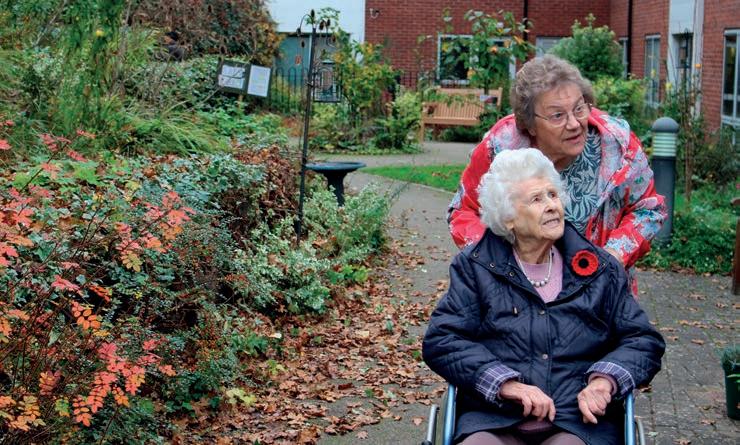
Have you won any awards for the garden?
We have links with Oadby and Wigston’s ‘Pride of the Borough’ who encouraged us to enter the RHS’s ‘It’s Your Neighbourhood’ element of East Midlands Britain in Bloom. We achieved ‘outstanding’ on our first a empt.
The volunteers were nominated for MHA Care Homes national Volunteer Team of the Year in 2024, and we came third. I was awarded MHA Care Homes national Volunteer of the Year in 2019, which was a complete surprise!
What do you love about gardening at Aigburth?
Being in the fresh air, whatever the weather, to create something of beauty to delight others. I love the cycle of the year and making leaf mould and compost to nurture the plants. Then there’s the magic when a group of visiting toddlers watch a dragonfly posing on logs at the pond. With this garden it’s as much about the people as the plants. The wildlife makes it more interesting for them, so I’m satisfied!
Contact us if you or someone you know could feature in a future issue of Wild. We’re looking for inspiring stories from people like you! Email info@lrwt.org.uk



Angelika von Heimendahl, beaver reintroduction manager at The Wildlife Trusts, shares her hopes for the recovery of beaver populations across the British Isles and the incredible benefits they bring to wildlife and river ecosystems.

Beavers are a native species to Britain that were hunted to extinction about 400 years ago. However, they are on the verge of a comeback! The reasons for their disappearance were not conflicts with humans, but their usefulness. Beaver fur was highly sought a er for making fashionable clothing and accessories and the scent gland excretions formed their basis of many perfumes. Even their meat was allowed to be eaten as they were considered aquatic animals. Beavers were hunted almost, but not quite, to extinction in Europe. So the hunting switched to North America, which led to the devastation of o er and beaver populations there too. Changing European fashion in mid-19th century Europe finally made beaver hunting uneconomic but by then it was too late: in Britain beavers had already been hunted to extinction. The beaver wetlands with their dams and ditches collapsed and were forgo en and the myriad of life that depended on those wetlands gradually declined.
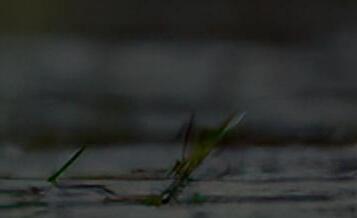
Beavers made a comeback
But this is not where the story ends. Beavers are incredibly adept at making a comeback. They dwindled to around 1,200 animals in Europe at the turn of the 20th century. But there are now more than 1.6 million of them sca ered across the mainland, resulting from reintroductions and natural recolonisation through strict protection. This has not been the case in islandBritain where reintroduction requires us to provide a helping hand by actively reintroducing beavers. This has led to different approaches in the devolved Governments. Scotland licensed wild beaver releases from 2009 and now have many sites with active beaver populations. Beavers are recognised as native species in Scotland and have been protected since 2019. In England the beaver was declared a native species and protected by law in 2022 but, so far, no wild release licences have been issued since the River O er Beaver Trial completed in Devon. Despite that, some escapees have made a successful home, especially in southwest England and Kent. In Wales, we welcome the recent announcement from the Welsh Government supporting the reintroduction of beavers to Wales and looking into safeguarding their populations. There have not yet been any authorised releases into the wild,
although small numbers of wild-living beavers are present.
The various trials around Britain show that beaver reintroduction is not problem-free but issues can be resolved helping humans and beavers to live and work alongside each other.
engineers ‘beaver’ away
The first time I saw a wetland created by beavers, I felt a sense of peace and calmness as though some evolutionary DNA inside me recognised this landscape. It is hard to describe how natural and ordered the pathways and dams are. Beavers do not flood their territory; rather they elevate water levels gently so they can move around more easily. They ‘beaver’ away, constantly adjusting water levels depending on whether the front door of their lodge is suddenly exposed, or the inside of the lodge starts to flood.
The dams they build are not as unforgiving as human structures and beavers listen to the flow of water rushing to repair any breaches. These ecosystem engineers create dams and ponds of varying sizes. This allows many different invertebrates and fish to lay their eggs in the resulting calmer and sometimes warmer water. In turn, this increases food, shelter and breeding opportunities for an abundance of wildlife.
In Estonia, for example, mute swans take advantage of their superior water
engineering skills and build their nests on top of beaver lodges to stay dry. Contrary to common perception, they rarely fell large trees, and instead prefer to coppice smaller trees along the streams such as aspen, birch and willow. These trees have co-evolved with beavers and naturally coppice, creating the juicy side shoots that beavers love.
So, can Britain once again live alongside beavers, where they become a normal part of our environment? Should we accept the new reality of a naturedegraded Britain in which most of us have forgo en what natural abundance looked like (o en called the shi ing baseline syndrome)?
Beavers are herbivores – so offer no significant threat to humans, livestock or pets – and can live happily in cities or in the countryside. And, given they provide the majority of urban dwellers an opportunity to see big wildlife up close, it is surely time to let them live free back in Britain.
Moreover, beaver wetlands slow the flow from upstream rain to downstream flood and improve water quality –hydrological engineering at no cost to taxpayers. It may seem surprising that beavers can achieve so much, but we forget that for millions of years, long before human se lements and


agriculture, they were the evolutionary force creating wetland ecosystems.
Despite the beaver’s success story there are regulatory hurdles to overcome. In Scotland the culling of beavers has become a control mechanism although the carrying capacity of the country is far from reached, with only around 1,000 beavers present. Bavaria – a similarsized region that is much more highly populated and agricultural – is home to around 25,000 beavers.
We would rather see efforts targeted at coexistence, including via translocation to other areas. Meanwhile, in England, we have yet to see guidance from regulatory authorities to reintroduce beavers, and there is no commitment from Welsh Government to allow beavers back or recognise them as a native species.
As the General Election campaign demonstrated, there is anger about the state of our rivers. They must be cleaned up and we must return the full abundance of life to our freshwaters. Beavers are a keystone species – they have a disproportionate impact on their environment given their numbers. One of the simplest and most cost-effective ways to restore our freshwaters to vitality is to welcome beavers again and watch them bring the richness back to our rivers and lakes.

Gnawed trunks are often a sign that beavers are living nearby.

Angelika von Heimendahl
is a vet and farmer, and recently joined The Wildlife Trusts as beaver reintroduction manager. She believes it is possible to create landscapes where nature thrives, people live and healthy food is produced.
The Wildlife Trusts have published A vision for the return of beavers to England and Wales making the case to end enclosures so beavers can be free in the wild again.
To support the ambition to bring back beavers to the wild, The Wildlife Trusts call on the UK and Welsh Governments to:
• Publish an ambitious beaver reintroduction strategy
• Fund farmers and land managers in the two countries to make more space for water on their land
• Support beaver management groups
• Confirm all wild beavers can remain in England and Wales




• Recognise beavers as a native species in Wales and provide them with full legal protection
























January – April 2025
Our full events programme can be found online. Check there for further details, including how to book, prices, times, and venue. Anyone booked on an event or volunteering activity will be notified of any changes. New events are constantly being added, so please check regularly for the latest updates: lrwt.org.uk/events
Ulverscro Mon 6 Jan, 10am
Winter Wildlife Walk
Discover the wintering thrushes and mammal tracks at the reserve. £10pp.
Cossington Meadows
Weds 8 Jan, 10am
Winter Wildfowl Walk
See what birds are about in the depths of winter as we explore the meadows. £10pp.


Charnwood Local Group
Weds 8 Jan, 7.30pm
Bringing a Boom to Middleton Lakes
Charnwood Local Group
Indoor meetings: Woodhouse Eaves Village Hall, 50 Main St, Woodhouse Eaves, Loughborough, LE12 8RZ. Admission £3 members, £3.50 non-members, children free. Check website for walk events. Contact Kate Moore on 01509 891005, katemoore123@yahoo.co.uk
Great Bowden Local Group
Indoor meetings: The Village Hall, The Green, Great Bowden, LE16 7EU. Admission £4. Contact Bruce White on 07919 935496
Melton Mowbray Local Group
Indoor meetings: United Reformed Church, 2 Chapel St, Melton Mowbray, LE13 1LZ.
Admission £1.50 members, £2 non-members. Contact Peter Dawson on 01664 852119, peter.dawson69@ntlworld.com
North West Local Group
Lyndon Nature Reserve
Sat 18 Jan, 10am – 1pm
Winter Bird Walk
Relaxing and informative guided walk perfect for anyone new to nature exploration. From £10pp.
Rutland Local Group
Mon 20 Jan, 7.30pm
Highs and Lows on the Nene Washes
RSPB warden of Nene Washes talks about this winter home to thousands of waterfowl and nesting cranes.
Lyndon Nature Reserve Fri 24 Jan, 2-4pm
Crafty Afternoon
Unwind with some art and great company. A variety of art materials will be provided to let your creativity flow. From £10pp.
Lyndon Nature Reserve Weds 29 Jan, 10am – 1pm
Guided Reserve Walk
Explore a range of hides and discover an array of wildlife species on this peaceful midweek stroll. From £10pp.
Admission £3. Contact David Maltby on 01530 222934 or Margaret Mabey on 01530 412410
Rutland Local Group
Indoor meetings: Volunteer Training Centre, off Oakham Road, Hambleton, LE15 8BP. Admission £2. Contact Becky Howard on 07908 252271
Leicestershire & Rutland
Badger Group
Meetings held online via Zoom. Contact Dr David Duckett on 0116 259 7231, info@ badgergroup.org.uk
Leicestershire & Rutland
Bat Group
Indoor meetings: Ashby Methodist Church, 5 Burton Road, Ashby-de-la-Zouch, LE65 2LF.
Talk by RSPB Reserve Manager Kate Thorpe on the bittern conservation success story at Middleton Lakes.
Melton Mowbray Local Group
Mon 13 Jan, 7pm
Spring Among the Clouds, part 2
A 17-day botanical journey, from Dali in Yunnan and finishing in Chengdu in Sichuan.
Rutland Water Nature Reserve: Volunteer Training Centre Sun 2 Feb, 10am - 12pm
Wetland Bird Surveys
Talk by Tim Sexton, Senior Species and Recording Officer. 2025 marks the 50th year of these essential surveys. £5pp.

Great Bowden Local Group
Weds 15 Jan, 7.30pm
James Adler Nature Reserve
Talk on how LRWT came to acquire this new, special reserve in Great Bowden.

Please wear warm clothes and appropriate footwear and bring a torch. Some bat detectors will be available but if you have your own, please bring it. Events may be cancelled in adverse weather. Walks are free to bat group members and £3 for others. Booking essential.
Lyndon Nature Reserve Weds 5 Feb, 10am – 1pm
Wellbeing Walk
Beginner-friendly guided walk to help you slow down, unwind and absorb the restorative benefits of being outdoors. From £10pp.
Melton Mowbray
Local Group
Mon 10 Feb, 7pm
Antarctic Explorers
North West Local Group Fri 17 Jan, 7.30pm Wildlife of Honduras
Kate Moore describes some of her wildlife encounters during a visit to the cloud forest of Cusuco National Park.


Jed Jaggard gives a talk on the heroic age of the Antarctic explorers.
Charnwood Local Group Weds 12 Feb, 7.30pm
The Secret Life of Flies
Entomologist Erica McAlister dispels many misconceptions about flies and reveals how truly exotic and important they are.






Early Morning O er Watches
Public dates: Jan 9, 24; Feb 8 (8-10am), & Feb 18, 21 (7.30-9.30am)
Lyndon Nature Reserve









Great Bowden Local Group
Weds 19 Mar, 7.30pm

Members only dates: Jan 14, 28 (8-10am)





Join us for an exciting early morning otter watch. These events offer a unique opportunity to potentially spot otters in their natural habitat, possibly even catching them in action as they fish. Public dates from £10pp. Members only dates free.
Leicestershire & Rutland
Badger Group
Thurs 13 Feb, 7.30pm Rutland Water Osprey Project Osprey Information Officer George Smith highlights details of this amazing reintroduction programme. The group’s AGM follows.
Lyndon Nature Reserve Sat 15 Feb, 10am – 1pm
Winter Bird Walk
See 18th Jan for details.
Lyndon Nature Reserve Mon 17 Feb, 10am – 1pm
Family Beginner Nature Walk
Guided walk perfect for families new to birdwatching and exploring the great outdoors. £15 per child, two adults per child ticket.
Rutland Local Group
Mon 17 Feb, 7.30pm
40 Years of the Yaxley Nature Conservation Project Talk about the vision, development and state of nature close to the village of Yaxley, Cambridgeshire.
Great Bowden Local Group

Weds 19 Feb, 7.30pm Bats in Leicestershire & Rutland
Illustrated talk about local bats, their importance, and the work of the Leicestershire & Rutland Bat Group.
Lucas Marsh
Thurs 20 Feb, 10am – 12pm Slugs and Snails Safari Hunt for slugs and snails and make a welcome sign for them in your garden. Free booklet to take home. Free members event.




Lyndon Nature Reserve Fri 21 Feb, 2-4pm
Crafty Afternoon
See 24th Jan for details.
North West Local Group Fri 21 Feb, 7.30pm
Butter y Project
Talk on a project to help spread local butterflies, including the purple emperor, through tree and shrub planting.
Melton Mowbray Local Group
Mon 10 Mar, 7pm Wildlife Spectacular
Wildlife and nature photographer Tony Clark takes us on a wildlife spectacular.
Charnwood Local Group
Weds 12 Mar, 7.30pm
AGM followed by Britain’s Rivers in Crisis
A look at the problems faced by UK rivers, who’s causing them, the impacts on wildlife, and what can be done about it.
Leicestershire & Rutland Badger Group
Thurs 13 Mar, 7.30pm River Restoration
Nene Wetlands Beaver Reintroduction
Talk on Nene Wetlands Nature Reserve. A family of beavers were due to be released at Delta Pit at the end of 2024.
Ke on Quarry Fri 28 Mar, 11am – 1pm Reptiles and Butter ies
Search for reptiles and butterflies basking in the spring sunshine in this pristine limestone grassland habitat. £10pp.
Lyndon Nature Reserve Thurs 3 Apr, 10am – 12pm
Members Osprey Experience
Enjoy a talk about ospreys then go spotting them in the hides at Lyndon. Free members event.
Lyndon Nature Reserve Weds 9 Apr, 2-4pm
Easter Osprey Trail
Family friendly adventure trail. Discover the story behind the Osprey Project and learn fascinating facts. £15 per child, two adults per child ticket.
Charnwood Local Group Weds 9 Apr, 7.30pm Borneo Wildlife Experience
Peter Proudlove takes us through the rainforests of Borneo on a mammal adventure, with a few other species thrown in.
Lyndon Nature Reserve Thurs 10 Apr, 10am – 12pm Members Osprey Experience See 3rd April for details.
Great Bowden Local Group Weds 16 Apr, 7.30pm Northamptonshire Butter ies Illustrated talk on Northamptonshire butterflies throughout the year.
Lucas Marsh
Thurs 17 Apr, 10am – 12pm & 1-3pm at hourly intervals
Easter Egg Nature Trail
Join the trail then craft a pompom animal to take home, make a plant pot and sow some herbs! Free for members.
Lyndon Nature Reserve
Thurs 24 Apr, 2-4pm Easter Osprey Trail See 9th April for details.
Cro Pasture
Mon 28 Apr, 10am – 12pm Croft Pasture Discovery Walk
Explore one of our smaller reserves. Croft Pasture is an amazing geological site formed by a glacier! Free for members.
Launde Park Wood
Weds 30 Apr, 10am - 12pm Woodland Walk
Join a bluebell walk, as you enjoy the birdsong and look for signs of badger activity. £10pp.


Cossington Meadows
Weds 30 Apr, 7.30-9.30pm Barn Owl Walk




Talk on the challenges of restoring Norfolk’s chalk rivers.



This evening walk offers the potential to admire these majestic birds. £10pp.

Rutland Local Group

Mon 17 Mar, 7.30pm

Leicestershire & Rutland Badger Group Thurs 10 Apr, 7.30pm The Charnwood Forest Regional Park Project
Talk about this scheme to protect and enhance the Charnwood Forest.



Lyndon Nature Reserve Mon 14 Apr, 2-4pm Easter Osprey Trail
See 9th April for details.



AGM followed by Dormice Reintroduction in VC55 Why dormice were reintroduced and how they are doing in their new woodland home. Check online for the full and latest programme of events











Over the coming year we have an ambitious plan to make a huge di erence to our counties. With your help, we will Restore, Reclaim and Renew, creating space for nature, building nature recovery networks, while giving nature an all-important voice.
This year we aim to raise £60,000 to increase our impact and bring our vision of a wilder Leicestershire and Rutland another step closer.
RESTORE: Creating Space for Nature
Our Strategy for 2030 is to secure 30% of land for nature’s recovery, increasing space for nature and reversing the decline in species. Your generosity will help us develop new nature reserves, enhance existing reserves, and secure new land for conservation.
RECLAIM: Building Nature Recovery Networks
Connecting people to nature by working with landowners, farmers and businesses can help us all work together for the bene t of nature. Your gifts will develop vital wildlife corridors as we foster strong partnerships to create a network of wildlifefriendly spaces.

RENEW: Giving Nature a Voice
We can help renew the connection to nature our communities need to support healthy lives, mental health and wellbeing. Your support will help to keep wildlife at the forefront of local agendas, as we expand our community outreach, enabling more people to connect with and protect the natural world.
Together, we will breathe new life into our counties.


